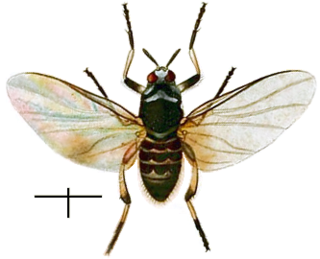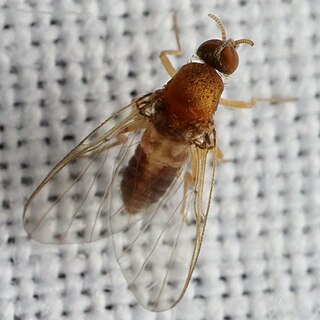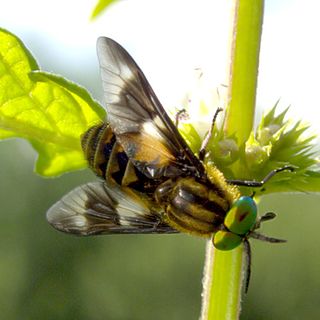
Enicocephalidae, also called unique-headed bugs and gnat bugs, are a family of around 300 species of the suborder Heteroptera. They are typically 4 mm (0.16 in) long, and found throughout the world. They have an elongated head, constricted in places, hence their head is 'unique'.

Chaoboridae, commonly known as phantom midges or glassworms, is a family of fairly common midges with a cosmopolitan distribution. They are closely related to the Corethrellidae and Chironomidae; the adults are differentiated through peculiarities in wing venation.

Simulium is a genus of black flies, which may transmit diseases such as onchocerciasis.

Gigantodax is a genus of 68 species of black flies distributed along the Andes from Mexico to Tierra del Fuego in Argentina.

Superfamily Tabanoidea are insects in the order Diptera.

Simuliinae is a subfamily of black flies (Simuliidae). It contains over 2,200 species, with over 1,800 of them in the genus Simulium. There are 2 tribes and 25 living genera. A further 5 genera are known only from Cretaceous fossils.
Prosimuliini is a tribe of black flies. It contains over 140 living species, with more than a half of them in the genus Prosimulium. There are 6 living genera, and 2 genera that are only known from Cretaceous fossils.
Cnephia is a genus of 9 species of black flies. They are distributed in scattered locations across the Northern Hemisphere, from Ukraine to Eastern Siberia, and some parts of North America.
Araucnephioides is a genus of black flies from Chile. There is only one known species.
Araucnephia is a genus of South American black flies from Chile and Argentina. There are only 2 known species.
Cnesia is a genus of 4 species of black flies. They are distributed in Argentina and Chile.
Formosia is a genus of flies in the family Tachinidae.

Rutilia is a large genus of medium to large (>20mm) flies in the family Tachinidae native to Australia and the Oriental region, though notably absent from New Zealand. Like the vast majority of tachinid flies, Rutilia species are parasitoids of other insects, specifically Rutilia are known to be parasitoids of late instar larvae of scarab beetles.
Pedrowygomyia is a genus of neotropical simuliid flies erected in 1998 from the Gigantodax cortesi species group of the 1925 genus Gigantodax after a cladistics analysis of the species groups recognized in the genus indicated that it was paraphyletic. The genus was named in recognition of the contributions to science of entomologist Petr Wolfgang Wygodzinsky. Pedrowygomyia originally comprised four species, P. cortesi, P. jatunchuspi, P. punapi and P. chacabamba, all described in 1989 from high-elevation areas in the Andean region. In 2020, a new species, P. hanaq, was described from the south-central Andes of Peru at an altitude above 4,000 m. Based on the pupal stage, the new species appears to be most closely related to P. punapi, a species known from Argentina, Bolivia, and Chile.

Pangoniinae is a subfamily of horse-flies in the order Diptera, containing at seven tribes and over 40 genera.

Dasybasis is a genus of horse flies in the family Tabanidae.
Aegophagamyia is a genus of horse flies in the family Tabanidae.
Chrysorutilia is a subgenus of flies in the family Tachinidae.
This page is based on this
Wikipedia article Text is available under the
CC BY-SA 4.0 license; additional terms may apply.
Images, videos and audio are available under their respective licenses.









